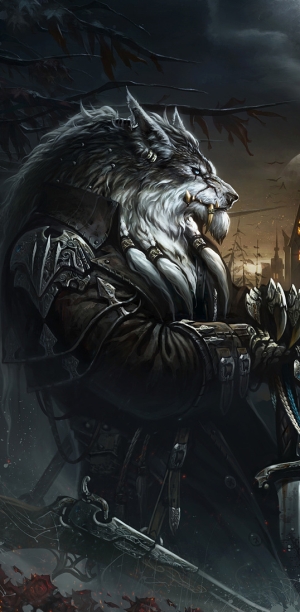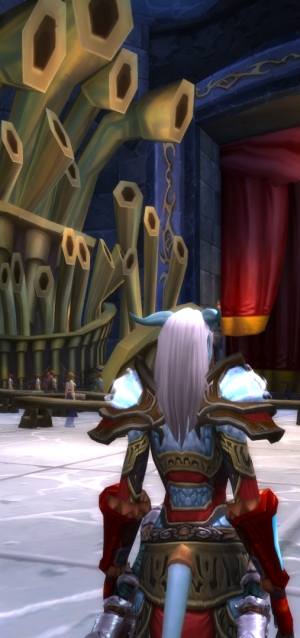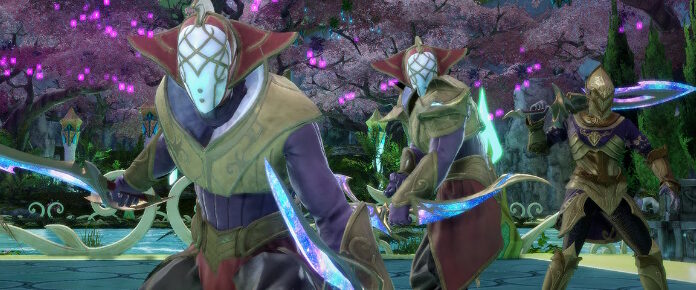
Antorus is out now, and if you want to see the cinematic that ends the very long-running story about the Burning Legion and Sargeras, well, that’s easy to do. It’s kind of spoiler-filled, though, so I’m not going to be talking about it here in any detail beyond mentioning that Azeroth does not exactly end things without a major impact. And needless to say, people have already started asking “why is it that World of Warcraft’s next expansion is going back to factional squabbles when this just happened?”
It’s a question with lots of good answers. So I want to dive into exactly those. In fact, you can neatly divide the answers up into three categories: The anthropic principle, real-life parallels, and the change of flavors. And it’s not that one or the other is the “real” answer or the “right” one; it’s that all three of them combine perfectly to make factional squabbles a perfectly reasonable next destination after the cosmic invasion of the last expansion.
Real-life parallels
 When did the Cold War start? Around 1947, with the first real armed conflicts starting up in 1949 or so. That’s a four-year turnaround between “allies” and “enemies.” And that was when we were just dealing with an abhorrent philosophy coupled with unchecked aggression as an enemy, not a cosmic horror bent on destroying the planet.
When did the Cold War start? Around 1947, with the first real armed conflicts starting up in 1949 or so. That’s a four-year turnaround between “allies” and “enemies.” And that was when we were just dealing with an abhorrent philosophy coupled with unchecked aggression as an enemy, not a cosmic horror bent on destroying the planet.
The reality is that the Alliance and Horde have a lot of reasons to dislike one another. Some of them work better than others, but at the end of the day, there’s no part of the Horde that hasn’t been victimized by some of the Alliance, and vice versa. The Warchief of the Horde literally watched her one chance at continuing her people’s society get demolished by an Alliance general, and said general watched his own nation fall due to that Warchief’s unchecked aggression. Hatred, resentment, and rage simmer beneath the surface for both sides.
Yes, both factions have worked together for the greater good frequently. But let’s not forget that the reality is that the Horde hasn’t ever had time to recover from a civil war that the Alliance helped stoke; both of them have been chasing one world-ending crisis after the other ever since. To the Horde, the Alliance has now led to the fall of two separate Warchiefs, assaulted a third, and then brought its finest soldiers to an alien world replete with Alliance forces; to the Alliance, the Horde not only abandoned them on the Broken Shore, they seem to have then allied with all of the political forces on the Broken Isles that both factions tried to liberate.
There’s a definite mark on the world after the end of the conflict on Argus, but that mark also means the conflict is over. What’s left? There’s no more Iron Horde, no more Deathwing, no more Legion or Scourge threat. Years of crisis after crisis, and both factions have reason to feel like the other side just kept making things worse in the midst of other troubles.
Really, it’s astonishing that both sides have managed to repeatedly work together when necessary, not that they’re happy to start bickering again. It’s much easier to understand the stakes when they’re immediate and personal, and the roots of the Horde-Alliance conflict are just that. There’s nothing cosmic there, just who gets to live where and who gets what resources.
Changing flavors
 Let’s assume, for a moment, that the map of World of Warcraft was decided upon long ago and hasn’t been changed multiple times. (This is demonstrably not true, but bear with me.) If this is the case, why did we go to Outland and then go to Northrend? For that matter, why didn’t we go to the Broken Isles before Northrend, since it’s on the way? Or Kul Tiras and Zandalar much earlier, such as around the time of the Cataclysm when everything was in upheaval?
Let’s assume, for a moment, that the map of World of Warcraft was decided upon long ago and hasn’t been changed multiple times. (This is demonstrably not true, but bear with me.) If this is the case, why did we go to Outland and then go to Northrend? For that matter, why didn’t we go to the Broken Isles before Northrend, since it’s on the way? Or Kul Tiras and Zandalar much earlier, such as around the time of the Cataclysm when everything was in upheaval?
Yes, some of the answer is “because the map is being made as the game expands.” But there’s a reason why the map keeps changing, and that’s the reason why we went from the etherial weird fantasy of The Burning Crusade to the grim rivets of Wrath of the Lich King. Or from the Eastern-themed Pandaria to the intentionally savage Draenor.
In real life, you don’t have cultures and places divided from neighbors. But for expansions like this, it’s important to have a distinct and different feel for each new destination. Not just for armor sets and the like, no, that’s just a symptom; what’s really important is feeling like each new destination feels new, different, and distinct. You aren’t just continuing in cosmic locales, you’re coming back home to a grounded place.
That extends in all directions, too. Warlords of Draenor was an awful expansion, but it told different sorts of stories from Pandaria, moving from factions and conflicts in stasis to an active adventure. Then we moved on to the Broken Isles and explored places of power, old problems we long had thought were buried, all ringed by burning green flame and the sheer overwhelming might of enemies. Each place, each story, each expansion feels different.
Making the next expansion “and now we go kill all the Old Gods” would feel like more of the same of Legion. No, it wouldn’t have the same aesthetics, but it would feel like the focus was on things that hadn’t actually changed; we’re still fighting against big cosmic forces. Having a different flavor is important for feeling like things are actually different.
For that matter, it allows seeding of the conflict to come. Legion in particular has done a good job of seeding that renewed factional conflict in the background all through the expansion, never as a focus but always present. It’s also been playing up the tragic side by showing that the various classes usually have more in common, that fundamentally all Paladins are part of the same group. But even that isn’t enough to actually keep the groups together.
Anthropic principle
 Last but not least, we have the anthropic principle, and this is one of those things that seems obvious when you hear it but also is easy to forget. In simplest terms, the anthropic principle in fiction is the idea that in order to have a story, you need to have the elements of a story.
Last but not least, we have the anthropic principle, and this is one of those things that seems obvious when you hear it but also is easy to forget. In simplest terms, the anthropic principle in fiction is the idea that in order to have a story, you need to have the elements of a story.
What does that mean? It means that in order to have a mystery story, you have to have a crime of some sort and someone trying to figure out what happened. In a superhero story, you have human beings capable of doing things beyond the limits of normal human beings and using that to fight threats beyond the normal caliber of what police deal with. And in a game with a factional conflict, you need to have at least two factions in conflict with one another.
The split between Horde and Alliance is hard-coded into the game, it’s been shot through every side of the game’s systems since launch. This is part of the game, full stop. That means that it also needs to be something with actual lore and gameplay to support it.
You can dislike the factional conflict, and I myself have some issues with how it’s been consistently implemented and zig-zagged multiple times. I get that. On the face of it, there’s a certain degree of weirdness at having a conflict that keeps going away sometimes but then getting dragged back into the limelight every so often. But the fact that it’s not always at the forefront of every single interaction doesn’t mean that it just goes away.
It’s right in the premise of the game. Heroes of the Alliance and the Horde fighting for the glory of their factions and against the threats to the world. In order to have the story, you need the elements of the story; in order to have a factional conflict, you need to have two factions, and you need them to be at odds, and while that conflict can simmer down it can’t ever actually be resolved.
Heck, the largely excellent post-Chaos Transformers comics from IDW specifically take place in the aftermath of the Autobot-Decepticon war, when theoretically factions are over and done with. And if you read the comic you see that factions still matter, that aspects of the conflict still flare right back up, and the official “war is over, we’re all on the same side” line doesn’t really stick over the long term.
So yes. After Antorus, we’re fighting amongst ourselves. And there are lots of good reasons for why, even taking into account that ending.
Feedback, like always, is welcome in the comments down below, or you can mail it along to eliot@massivelyop.com. And let’s remember, of the game’s expansions, we’ve had at least one great one without a clear and obvious enemy to fight from the start and two awful ones that gave us straightforward, strong enemies that were separate from factional conflicts. So it’s a bit early to judge on that basis.
 War never changes, but World of Warcraft does, with a decade of history and a huge footprint in the MMORPG industry. Join Eliot Lefebvre each week for a new installment of WoW Factor as he examines the enormous MMO, how it interacts with the larger world of online gaming, and what’s new in the worlds of Azeroth and Draenor.
War never changes, but World of Warcraft does, with a decade of history and a huge footprint in the MMORPG industry. Join Eliot Lefebvre each week for a new installment of WoW Factor as he examines the enormous MMO, how it interacts with the larger world of online gaming, and what’s new in the worlds of Azeroth and Draenor.














